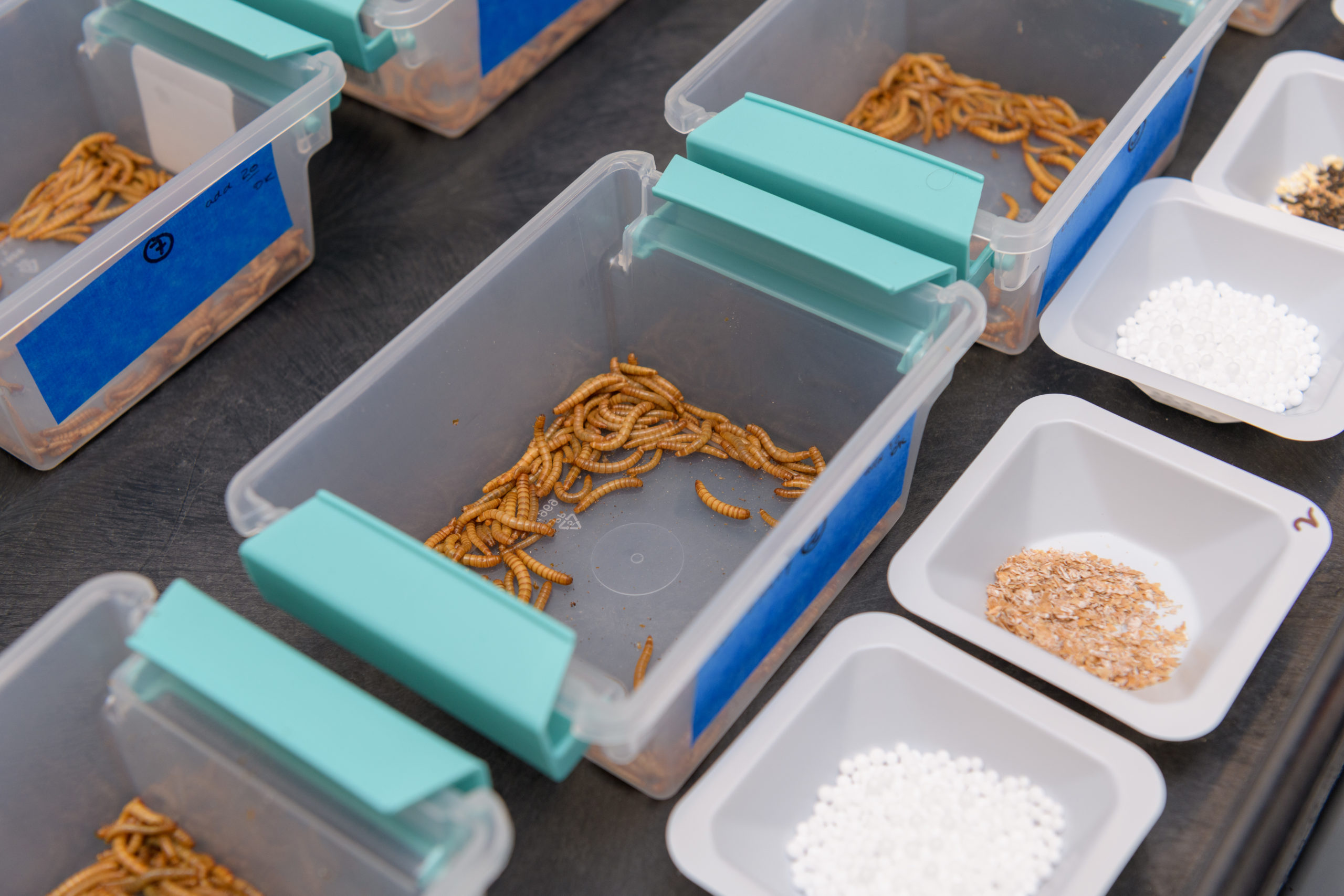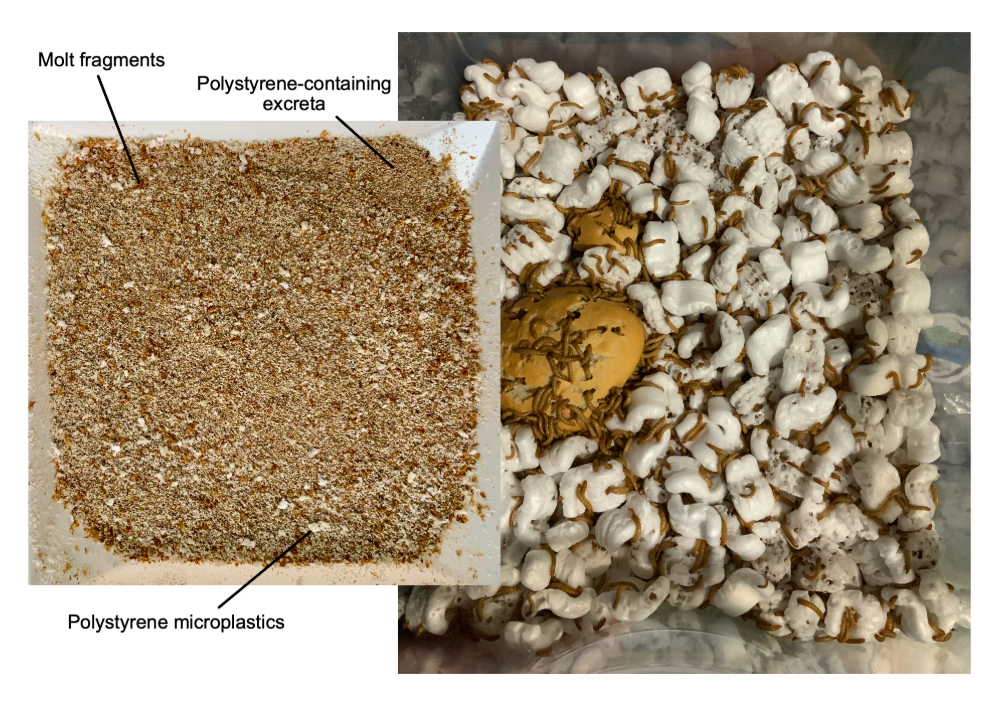Insect microbes face off against the plastic pollution crisis
Plastic-eating enzymes in the guts of mealworms are one of many bug-centric ideas being studied, but environmentalists say it dodges the real solution: use less
Jenaye Johnson • January 4, 2024

Yellow mealworms bunch together in plastic bins, eager to feast on their main meal of the day: solid plastic balls roughly the size of their bodies. [Credit: Evan Krape | All rights reserved, with permission from the University of Delaware]
Lined up in bins on a lab table, hundreds of yellow-brown mealworms, fresh out of a warm incubator, wriggle in anticipation over what’s coming next: a hearty lunch of polyolefin plastic.
Polyolefin is the same plastic used in thousands of products — everything from clear plastic bags and water bottles to cardboard box linings and cling film — and it’s easy to see why. They have almost all the properties needed in a plastic: strength, flexibility, transparency, and they’re cheap to manufacture.
Almost, because there is a huge problem with polyolefin. Like many plastics, the material is very difficult to degrade or recycle, which is why bioengineer Mark Blenner is feeding white plastic balls to mealworms at his University of Delaware lab. He wants to find a new way to get rid of a ubiquitous plastic that usually ends up landfilled, incinerated or just tossed aside.
“We were really hoping to see if there was any way that microbiology … could help with the plastic deconstruction problem,” explains Blenner.
Microbial enzymes in the guts of mealworms can break down even the toughest plastics, which is why he says they could someday be part of the solution for a world awash in plastic waste. He’s spearheading several projects he hopes will “take advantage of these amazing microbes and their abilities, to help make a more sustainable society.”
Plastic is everywhere it shouldn’t be. Globally, only 9% of plastic waste is properly recycled, and there is potential for almost 69 million tons of plastic to end up in the ocean or soil this year. Plus, plastic waste poses health risks ranging from cancer to neurodevelopmental issues, according to the Geneva Environment Network.
Researchers around the world are looking to insects as a promising, though partial, solution. They’re scrutinizing plastic-eating microbes in at least 11 species of insects, including superworms, and the larvae of wax moths and dark mealworms — a species closely related to Blenner’s. The startup Plasticentropy, for example, has identified wax caterpillar enzymes dubbed Demetra and Ceres that can dissolve thin layers of plastic in hours.
All the activity, however, has some environmentalists worried that it could distract from the goal of using less plastic in the first place.
“There’s a potential risk about research that comes out about plastic degrading bacteria, where the response is ‘Oh, we don’t need to worry about this problem anymore,’ when we still do,” says Anja Brandon, who works on plastic policy at the D.C.-based nonprofit Ocean Conservancy. “We cannot rely on these technology silver bullets to save us.”
Brandon should know: Before she became an activist pushing companies to cut plastics use, she isolated bacteria like Citrobacter sp. and Kosakonia sp. from yellow mealworms to be used for plastics recycling during her PhD.
The larvae have been a particularly attractive target because they have a special kind of gastric system that could be used to make biodegradable plastic. Their stomachs house hundreds of microbes, like a miniature bioreactor. While many of these microbes use enzymes to break down typical food sources such as leaves and other insects, several studies have documented that certain enzymes in the worms can cut plastics down into microscopic components.
Yellow mealworms can devour some of the most widely used plastics, including polystyrene (packing peanuts), polyethylene terephthalate (shopping bags), polypropylene (yogurt cups), polyvinyl chloride (cable insulation), and even rubber, according to Wei-min Wu, a retired mealworm research engineer who is not affiliated with the Delaware project.
To consume even the toughest plastics, mealworms slice the plastic into chunks small enough to enter their guts. Then, the microbes in the bugs’ gastric system get started. Enzymes attach to chemical surfaces and break down long chains of polymer molecules into smaller pieces. These monomers are then excreted by the mealworms and could one day be available for bioengineers to reuse in future plastic products.
Blenner is working on removing those microbes from the mealworms and setting them loose directly on plastics — a necessary step toward eventually creating feasible industrial-scale recycling processes. It could also eventually lead to the design of new kinds of plastic that decompose faster.
But identifying and isolating bacterial communities and their respective enzymes in mealworms can be tricky. Mealworms have hundreds of bacteria species, and the introduction of plastic to their diet can muddy methods to determine which ones are key players. At the moment, Blenner has found just one enzyme strain out of roughly 40 that is good at tearing apart multiple types of polyolefins. His team plans to isolate the enzyme, study its genetic structure and then search for more enzymes that resemble it.
He needs to solve another problem, too: Once the microbial enzymes are removed from worm guts, Blenner says they become less efficient at breaking down plastics. Removing the enzymes “changes the microbe type and how many of each type of microbe there are,” he says. “So, it’s not the same as what’s happening in the gut. It’s also different environments.”

Mealworm larvae can mechanically break down tough plastic fragments. Ongoing research is investigating how gut microflora can biodegrade synthetic materials. [Credit: Juan C. Sánchez-Hernández | All rights reserved, with permission from the University of Castilla-La Mancha]
Many teams around the globe are doing similar research. In Spain, a research lab led by ecotoxicologist Juan Sánchez-Hernández is considering how the mealworms’ diet affects the efficiency of plastic breakdown. The health of a mealworm plays a vital role in their work ethic. “We need to understand if the mealworm is living well when you give them plastic as food,” Sánchez-Hernández says. “If the mealworm only eats plastic, in three weeks you will find it will have a high percent of mortality, which is not useful long-term.” To mitigate this, Sánchez-Hernández suggests providing the mealworms with vitamins and nutrients beyond just plastic.
The Ocean Conservancy’s Brandon worked in Wu’s laboratory for years, but now her interests have shifted. She has become skeptical that plastics re-engineered by tiny insects will ever make a significant dent in the global plastics pollution problem. Instead, she is pushing for tougher regulations that would force plastics manufacturers to pay for the costs of getting rid of their products. That’s the best way, she says, to drive down global plastics use.
Blenner says she has a valid point. Even if his mealworm research someday spurs more plastics recycling, he says the scale of the problem is so vast that mealworm enzymes can only be a small part of the solution. After all, it would take billions of mealworms to degrade even 1% of the world’s plastic waste.
“Anyone that thinks a single solution will present itself is being unrealistic,” Blenner says. “The problem will require a lot of different smaller solutions.”